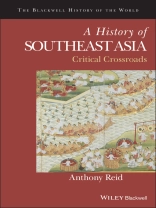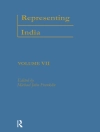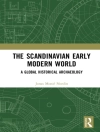2016 PROSE Award Honorable Mention for Textbook in the Humanities
A History of Southeast Asia: Critical Crossroads presents a comprehensive history of Southeast Asia from our earliest knowledge of its civilizations and religious patterns up to the present day.
* Incorporates environmental, social, economic, and gender issues to tell a multi-dimensional story of Southeast Asian history from earliest times to the present
* Argues that while the region remains a highly diverse mix of religions, ethnicities, and political systems, it demands more attention for how it manages such diversity while being receptive to new ideas and technologies
* Demonstrates how Southeast Asia can offer alternatives to state-centric models of history more broadly
Part of The Blackwell History of the World Series
The goal of this ambitious series is to provide an accessible source of knowledge about the entire human past, for every curious person in every part of the world. It will comprise some two dozen volumes, of which some provide synoptic views of the history of particular regions while others consider the world as a whole during a particular period of time. The volumes are narrative in form, giving balanced attention to social and cultural history (in the broadest sense) as well as to institutional development and political change. Each provides a systematic account of a very large subject, but they are also both imaginative and interpretative. The Series is intended to be accessible to the widest possible readership, and the accessibility of its volumes is matched by the style of presentation and production.
Tabela de Conteúdo
List of Tables xi
List of Maps xii
List of Illustrations xiii
Series Editor’s Preface xiv
Preface xvii
Glossary xxii
Abbreviations xxv
1 People in the Humid Tropics 1
Benign Climate, Dangerous Environment 1
Forests, Water, and People 4
Why a Low but Diverse Population? 6
Agriculture and Modern Language Families 10
The Rice Revolution and Population Concentration 13
The Agricultural Basis of State and Society 16
Food and Clothes 18
Women and Men 21
Not China, not India 26
2 Buddha and Shiva Below the Winds 30
Debates about Indic States 30
Bronze, Iron, and Earthenware in the Archaeological Record 32
The Buddhist Ecumene and Sanskritization 34
Shiva and Nagara in the ‘Charter Era, ‘ 900-1300 39
Austronesian Gateway Ports – the Negeri 45
Dai Viet and the Border with China 47
The Stateless Majority in the Charter Era 49
Thirteenth/Fourteenth?]Century Crisis 53
3 Trade and Its Networks 57
Land and Sea Routes 57
Specialized Production 59
Integration of the Asian Maritime Markets 62
Austronesian and Indian Pioneers 63
The East Asian Trading System of 1280-1500 65
The Islamic Network 69
The Europeans 71
4 Cities and Production for the World, 1490-1640 74
Southeast Asia’s ‘Age of Commerce’ 74
Crops for the World Market 76
Ships and Traders 80
Cities as Centers of Innovation 81
Trade, Guns, and New State Forms 85
Asian Commercial Organization 91
5 Religious Revolution and Early Modernity, 1350-1630 96
Southeast Asian Religion 97
Theravada Cosmopolis and the Mainland States 98
Islamic Beginnings: Traders and Mystics 101
Polarizations of the First Global War, 1530-1610 106
Rival Universalisms 111
Pluralities, Religious Boundaries, and the ‘Highland Savage’ 114
6 Asian European Encounters, 1509-1688 120
The Euro?]Chinese Cities 120
Women as Cultural Mediators 125
Cultural Hybridities 130
Islam’s ‘Age of Discovery’ 133
Southeast Asian Enlightenments – Makassar and Ayutthaya 135
Gunpowder Kings as an Early Modern Form 139
7 The Crisis of the Seventeenth Century 142
The Great Divergence Debate 142
Southeast Asians Lose the Profits of Long?]Distance Trade 144
Global Climate and Local Crises 149
Political Consequences of the Crisis 152
8 Vernacular Identities, 1660-1820 157
Eighteenth?]Century Consolidation 157
Religious Syncretism and Localization 158
Performance in Palace, Pagoda, and Village 167
History, Myth, and Identity 172
Consolidation and its Limitations 175
9 Expansion of the Sinicized World 177
Fifteenth?]Century Revolution in Dai Viet 177
Viet Expansion, Nam Tien 179
Cochin?]China’s Plural Southern Frontier 183
The Greater Viet Nam of the Nguyen 185
The Commercial Expansion of a ‘Chinese Century, ‘ 1740-1840 188
Chinese on Southern Economic Frontiers 191
10 Becoming a Tropical Plantation, 1780-1900 196
Pepper and Coffee 197
Commercialization of Staple Crops 198
The New Monopolies: Opium and Tobacco 200
Java’s Coerced Colonial Agriculture 204
Plantations and Haciendas 207
Mono?]crop Rice Economies of the Mainland Deltas 209
Pre?]colonial and Colonial Growth Compared 211
11 The Last Stand of Asian Autonomies, 1820-1910 213
Siam as ‘Civilized’ Survivor 214
Konbaung Burma – a Doomed Modernization 219
High Confucian Fundamentalism – Nguyen Viet Nam 224
‘Protected’ Negeri 227
Muslim Alternatives in Sumatra 230
Bali Apocalypse 233
Mobile ‘Big Men’ in the Eastern Islands 235
The Last State Evaders 237
12 Making States, 1824-1940 240
European Nationalisms and Demarcations 240
From Many to Two Polities in Nusantara 241
Maximal Burma, Viable Siam 246
Westphalia and the Middle Kingdom 250
Building State Infrastructures 251
How Many States in Indochina? 255
Ethnic Construction in the New Sovereign Spaces 256
States, not Nations 260
13 Population, Peasantization, and Poverty, 1830-1940 261
More People 261
Involution and Peasantization 263
Dual Economy and the Absent Bourgeoisie 266
Subordinating Women 268
Shared Poverty and Health Crises 272
14 Consuming Modernity, 1850-2000 276
Housing for a Fragile Environment 276
The Evolution of Foods 278
Fish, Salt, and Meat 279
Stimulants and Drinks 281
Cloth and Clothing 284
Modern Dress and Identity 286
Performance, from Festival to Film 289
15 Progress and Modernity, 1900-1940 295
From Despair to Hope 296
Education and a New Elite 302
Victory of the National Idea in the 1930s 306
Negotiating the Maleness of Modernity 314
16 Mid?]Twentieth?]Century Crisis, 1930-1954 319
Economic Crisis 319
Japanese Occupation 323
1945 – the Revolutionary Moment 331
Independence – Revolutionary or Negotiated? 341
17 The Military, Monarchy, and Marx: The Authoritarian Turn, 1950-1998 347
Democracy’s Brief Springtime 347
Guns Inherit the Revolutions 350
Dictatorship Philippine Style 358
Remaking ‘Protected’ Monarchies 359
Twilight of the Indochina Kings 364
Reinventing a Thai Dhammaraja 367
Communist Authoritarianism 370
18 The Commercial Turnaround, 1965- 373
Economic Growth at Last 373
More Rice, Fewer Babies 376
Opening the Command Economies 378
Gains and Losses 380
Darker Costs – Environmental Degradation and Corruption 384
19 Making Nations, Making Minorities, 1945- 390
The High Modernist Moment, 1945-1980 390
Education and National Identity 394
Puritan Globalism 400
Joining an Integrated but Plural World 405
20 The Southeast Asian Region in the World 413
The Regional Idea 414
Global Comparisons 419
References 423
Further Reading 431
Index 436
Sobre o autor
ANTHONY REID is Professor Emeritus at the College of Asia and the Pacific, Australian National University. He has taught and researched Southeast Asian history for 50 years, in Malaysia, Indonesia, Singapore, Australia, and the United States. He was Founding Director of the Asia Research Institute in Singapore. He has authored or edited numerous books on aspects of Southeast Asian history from the fourteenth to the twenty-first centuries, including explorations on slavery, freedom, Islam, gender, the Chinese minority and its Jewish analogy, population, and economic history.












